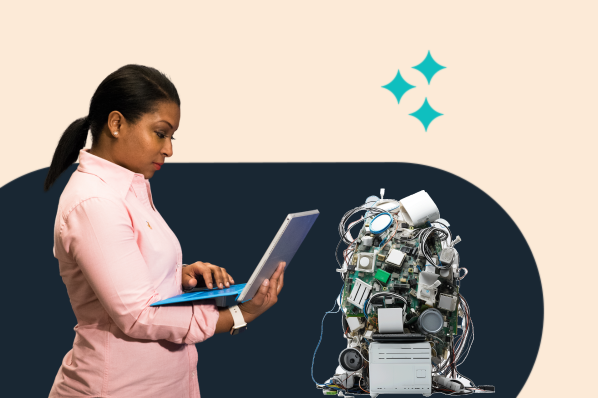I’ll be honest. For someone who writes about artificial intelligence as much as I do, I’m a bit behind on my knowledge of science fiction. As much as my father implored, I could never quite build an enthusiasm for Star Trek. And to the lament of many ex-boyfriends, I was never exactly a Star Wars enthusiast, either. But lately, that's been changing. My interest in movies about robots has piqued. My guess: It has something to do with many elements of these films permeating our real lives.
Science fiction, as a film genre, has technically been around since the era of silent movies -- the 1902 short Voyage Dans La Lune (translation: A Trip to the Moon) is a prime example. But as real-life science progressed, so did that invented by authors, screenwriters, and filmmakers. We went from merely imagining travel to the moon in the previous example, to inventing a world in which someone can fall in love with an artificially intelligent voice with no face or body, like in the 2013 film Her. Check out our interactive guide to creating high-quality videos for social media here.
But when it comes to artificial intelligence, there are some movies that are starting to eerily come to life as the science realm is getting better and better at inventing consumable technology that's, at times, remarkably similar to the kind seen in these films. We picked out the five that stand out most to us, and which of today's AI technologies best match them.
5 Artificial Intelligence Movies That Have Become a Reality
1) Forbidden Planet
Fiction: Robby the Robot
I won't lie -- there are several moments throughout the week when I think to myself, "I could really go for a donut right now." It conjures images of the 1956 film Forbidden Planet, in which the Robby the Robot character prepares a meal of donuts for a group of space travelers. How convenient.
Reality: Robochef
In the movie, the robot is able to do that after being "fed" a sample of the food, which is analyzed in an internal lab and can then reproduce. And while today's real-life cooking chef doesn't exactly emulate that science, it comes close. The robochef depicted in the video below memorizes human actions by recording the movements of an actual chef via three-dimensional camera, and translates them "into highly precise movements," according to IFLScience.
2) 2001: A Space Odyssey
Fiction: HAL 9000
The HAL 9000 -- or as its peers refer to it, simply “Hal” -- is a portrayal of a nightmare artificial intelligence scenario. Basically, a space crew that was merely supposed to be assisted by Hal ends up being outsmarted by it, as per the clip below.
Reality: Siri
It’s hard to imagine that an army of Siris alone could overtake the human race -- in fact, she might even be considered a more primitive version of Hal. But like her fictional counterpart, she can engage with humans on a conversational level. And, her snark often matches Hal’s -- just look at her response when you ask her an innocent math question.
3) WALL-E
Fiction: WALL-E
This film is named for its hero and main character: A tiny robot named WALL-E. Left all alone on Earth after all humans have abandoned the planet, this artificially intelligent being spends his days essentially cleaning up after what was left behind on the planet, which explains why his name stands for “Waste Allocation Load Lifter Earth-class.” He can see, he can sigh, and he can even befriend a cockroach, which -- quite fittingly -- he names Hal.
Reality: Cozmo
In the summer of 2016, it was announced that the Anki company would release Cozmo: “A real-life robot like you’ve only seen in movies,” the product description reads, “with a one-of-a-kind personality that evolves the more you hang out.” Like WALL-E, Cozmo goes through the process of waking up and starting its day, and even shows signs of emotion -- like when it gets knocked on its side and begins to emulate frustrated behavior. But don’t feel bad. It also exhibits signs of happiness while playing games.
4) Back to the Future Part II
Fiction: Video Chat, News Drones, and More
It seems that there were so many (at least somewhat) accurate predictions made in Back to the Future Part II, it’s hard to fit them all into a short description. But some of the more notable ones include a video call that the protagonist, Marty, receives from his boss during a flash-forward -- something that, at the time of the movie’s release, wasn’t a commodity like it is today with platforms like Skype and FaceTime.
But our favorite scene might be the one with a futuristic, hovering USA Today camera that captured images and footage for the news -- without human operation.
Reality: USA Today Drone
USA Today decided that a legacy like this one was too good to not take advantage of it, so the news outlet commissioned the engineers at FliteTest to create a real-life, branded news drone. The result, while still in a somewhat primitive form, was a fully-built news drone complete with flight and 360° video recording capabilities.
5) Ex Machina
Fiction: Ava
There’s quite an extensive history of efforts to build artificially intelligent devices or creatures that can can engage with humans on an emotional level. It began with a computerized chatbot -- the 1951 Turing Test, a.k.a., the Imitation Game -- which was designed to respond to human inquiries with equally human language. And since then, there have been many fictional representations of eerily life-like (and intelligent) robots that stir deep attachments in their human counterparts. That’s been central to the plotline of movies like the aforementioned Her and, as seen below, Ex Machina.
Reality: Pepper
World, meet Pepper: One of the latest artificial intelligence products from SoftBank Robotics. It almost feels wrong to refer to Pepper as a product, since it’s programmed to interact with humans like, well, another human -- so much so that it’s been “adopted” by several families in Japan.
What really sets Pepper apart is its ability to interpret human emotions, and conversationally respond in kind. Some might argue, though, that this robot hardly interacts exactly like a human, since there’s a lag between the human’s question and Pepper’s response during which the input has to be analyzed. Still, unlike many of today’s similar devices, Pepper can shake the hands of new people it meets, answer questions, and offer hugs. As the saying goes -- we’re getting there.
Get Real
Of course, some of these examples are coming to life more identically to their fictional counterparts than others -- the USA Today instance, for example, is pretty similar.
But when you consider that some of these films were released as recently as 2015, and we've come even closer to emulating its featured technologies in the short period of time that's passed since then, we have little doubt that even the most spectacular of AI inventions will come to fruition. And as reality becomes more remarkable -- we can't wait to see what the SciFi world invents next.
Which AI movies would you like to see come true? Let us know in the comments.







![Which LLM Should You Use for Your Business? [Pros and Cons]](https://www.hubspot.com/hubfs/which%20llm%20to%20use.png)

![Is it Real or AI? Test Your Detection Skills [Round 4]](https://www.hubspot.com/hubfs/real%20or%20ai%204.png)


![Which AI Tool Writes the Best Marketing Copy? [I Tested Several Different Tools]](https://www.hubspot.com/hubfs/Untitled%20design%20%2842%29-1.jpg)